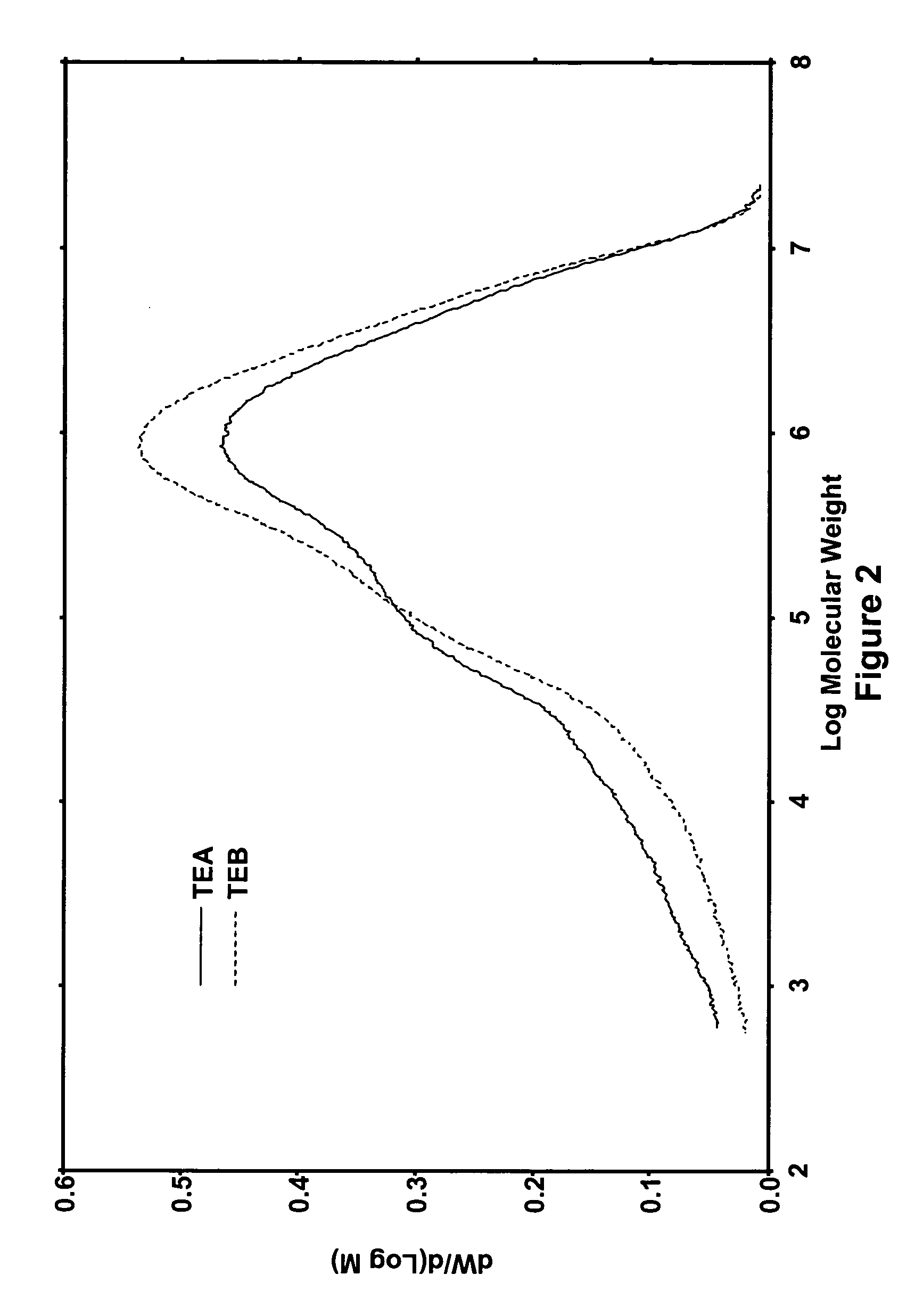Methods of preparing active chromium/alumina catalysts via treatment with sulfate
a technology of active catalysts and chromium alumina, which is applied in the direction of metal/metal-oxide/metal-hydroxide catalysts, aluminium oxides/hydroxides, chemical/physical processes, etc., can solve the problems of inability to produce very high molecular weight polymers, inability to provide ultra-high molecular weight polymers, and undesirable properties
- Summary
- Abstract
- Description
- Claims
- Application Information
AI Technical Summary
Benefits of technology
Problems solved by technology
Method used
Image
Examples
example 1
[0042]The following procedure was repeated 3 times to form 3 different catalyst samples (samples 1, 2, and 3). An alumina support (alumina “A”) purchased from W. R. Grace Company was calcined in nitrogen at 600° C. in preparation for its use as a catalyst. The support had a surface area of about 280 m2 / g and a pore volume of about 1.5 cc / g. The alumina support was then impregnated with various amounts of ammonium sulfate in aqueous solution as shown in Table 1 below, followed by drying the support in a vacuum oven at 100° C. for about 10 hours. The support was then impregnated with a methanolic solution of Cr(NO3)3 to incorporate chromium therein, followed by drying it in a vacuum oven at 100° C. for about 10 hours. The resulting catalyst precursor was then activated by calcination in dry air for about 3 hours at 600° C.
[0043]Table 1 shows several physical properties of the activated catalyst samples and the compositions of the catalyst samples. Table 1 further provides the weight p...
example 2
[0046]Catalyst samples (samples 4–9) were prepared in the same manner as described in Example 1 with different amounts of sulfate except that sample 4 contained no sulfate. The amount of sulfate added to each catalyst sample and the weight percent of hexavalent chromium (Cr VI) contained in each sample by total weight of the sample are shown in Table 2 below.
[0047]A polymerization run using each catalyst sample was made in a 2.2 liter steel reactor equipped with a marine stirrer rotating at 400 rpm. A steel jacket containing boiling methanol with a connection to a steel condenser surrounded the reactor. The boiling point of the methanol was controlled by varying nitrogen pressure applied to the condenser and jacket, which permitted precise temperature control to within half a degree centigrade, with the help of electronic control instruments. A small amount (about 0.04 to 0.10 grams) of the catalyst sample was first charged under nitrogen to the dry reactor. Next 1.2 liter of isobut...
example 3
[0051]A catalyst treated with 20 parts of ammonium sulfate per 100 parts by weight of alumina was made according to the procedure described in Example 1. The catalyst contained 2% Cr by weight of the alumina. It was calcined at 600° C. for activation, and then it was used to polymerize ethylene at 95° C. and 550 psig according to the procedure described above, with the exception of two changes. First, two of the runs were performed using 8 ppm of triethylaluminum (TEA) as the cocatalyst, and two runs were performed using 8 ppm of triethylboron (TEB) as the cocatalyst. Second, 50 psig of H2 was added to the autoclave after isobutane addition but before ethylene addition. This was done during each run to decrease the molecular weight of the polyethylene resin formed in each run. Despite the large amount of hydrogen added, the polyethylene resins still had HLMI values of zero. FIG. 2 illustrates the molecular weight distributions of the polyethylene resins produced in those runs. As ca...
PUM
| Property | Measurement | Unit |
|---|---|---|
| temperature | aaaaa | aaaaa |
| temperature | aaaaa | aaaaa |
| temperature | aaaaa | aaaaa |
Abstract
Description
Claims
Application Information
 Login to View More
Login to View More - R&D
- Intellectual Property
- Life Sciences
- Materials
- Tech Scout
- Unparalleled Data Quality
- Higher Quality Content
- 60% Fewer Hallucinations
Browse by: Latest US Patents, China's latest patents, Technical Efficacy Thesaurus, Application Domain, Technology Topic, Popular Technical Reports.
© 2025 PatSnap. All rights reserved.Legal|Privacy policy|Modern Slavery Act Transparency Statement|Sitemap|About US| Contact US: help@patsnap.com



